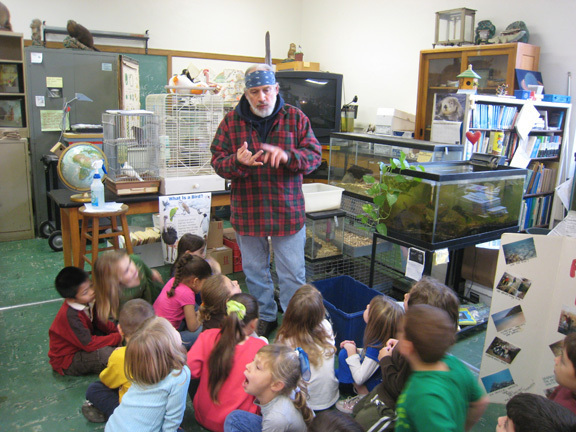Kids get a hands-on lesson in nature study
On certain weekdays, visitors to Oceanside School #6 may see elementary students from the school district armed with magnifying glasses, peering into aquariums and taking observational notes. Surrounded by live animals, preserved specimens, and scientific models, these amateur ecologists are getting a hands-on lesson at the Nature Study Center.
Ned Black, who taught biology, earth science and marine science in the district, started the Nature Study Center as an after-school program more than two decades ago. Over the years, he built his collection, adding to it with donations and purchases approved by the school. As the center expanded, it became a more formal part of School #6. Toward the end of his career, Black said he was teaching classes regularly at the center, as well as visiting classes and giving lectures.
So when it came time for Black to retire about three years ago, he naturally had some trouble giving up his work at the center. Black asked the district to keep the program, and decided to return to the school to run it.
Now, he teaches lessons to pre-K, kindergarten, first, third, and sixth graders. The program is cumulative, and the older students use what they've learned at the center on field trips. The third graders visit the Oceanside Marine Nature Study Area, a salt marsh preserve in the Town of Hempstead, and the sixth graders visit Jones Beach to collect data. Students also participate in a global project known as JASON, where they can post their findings online and communicate with professional scientists and explorers from around the world through live discussions on the project's Web site.
At the center, students are given some time to explore before they sit down for a lesson with Black. The center has live mammals, birds, reptiles, amphibians and fish, including crabs, turtles, lizards, a snake, doves, gerbils, and a rabbit. There are also stuffed animals, which Black said were donated by a retiring teacher whose husband worked as a taxidermist. The center also has glass cases and cabinets filled with labeled bone, marine, plant, insect and rock specimens. Books, crayons, magnifying glasses and microscopes can be found throughout the room.
This month, all of the district's first graders are visiting the center. On Dec. 4, Allison Okun's first-graders, from School #8, stopped by for a lesson on marine ecosystems. Their enthusiasm was palpable; as soon as the students reached the door to the center, they were off and running, picking up seashells, stuffed animals, books and magnifying glasses to get a closer look.
After the students had some time to explore, Black had them sit down for a lesson on the web of life and biotic (living) and abiotic (non-living) specimens. They picked up quickly, and armed with their new vocabulary, took off to complete the day's experiment: observing an aquarium and drawing and labeling a picture of a fish. Black also made the students their own mini aquarium, in a soda bottle, to take back to class.
Okun said the students will observe the aquarium and keep journals on the changes they see as part of their unit on marine life. She said their time at the Nature Study Center motivates them to explore the possibilities of science. “They're excited,” she said. “They love science. It's very hands-on for them.” As they worked on drawings of fish, first-graders Michelle Fogel and Benjamin Schmidt, both 6, said they had fun at the center. Michelle said she learned about the difference between biotic and abiotic, and Benjamin's favorite part of the visit was observing fish in the aquarium.
Maintaining the Nature Study Center is a labor of love for Black, and he hopes to impart the importance of ecological awareness on his young students. “Preservation of natural habitat is, in my mind, one of the most important aspects of the environmental movement,” he said. “It means the survival of people.” Black hopes the study of ecology, which he defines as “the study of the interaction of organisms with one another and their environment,” will help teach students about their role in the natural world and the importance of protecting it.
For Black, the Nature Study Center was a natural progression of his life's work. He earned his undergraduate degree in secondary science education, with a major in biology and a minor in earth science, at the State University of New York at New Paltz. He earned a master's degree in marine science education at Long Island University. Black said animals have always been a part of his life, and he can remember taking in and caring for strays as a child.
On weekdays, he can be seen around School #6, with a signature Canadian Goose feather in his sweatband. He said it reminds him of Native American culture, and provides “a good nature study hat.” If there's one lesson he'd like to impart on his young students, Black said it's appreciation: “An appreciation for the natural world and preservation of natural habitat.”
Comments about this story? AFertoli@
liherald.com or (516) 569-4000 ext. 269.









